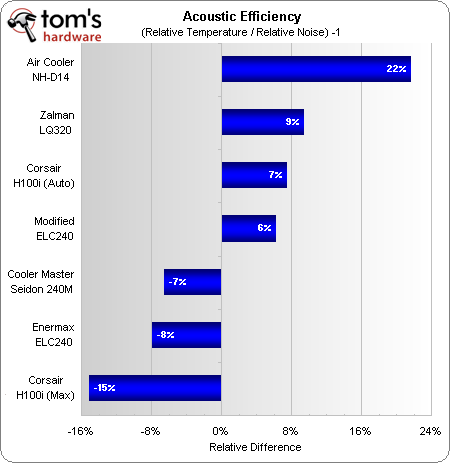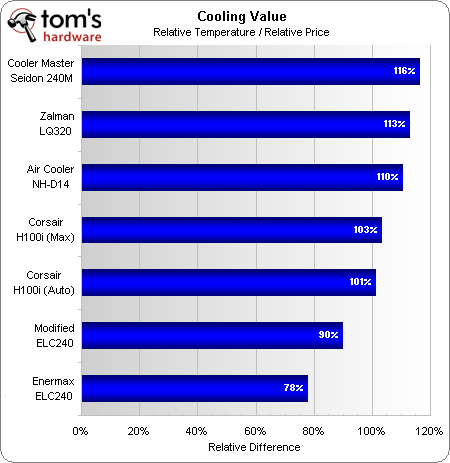Four Closed-Loop CPU Coolers Take On Noctua's NH-D14
Closed-loop liquid coolers relieve stress from our motherboards, without the portability and maintenance issues of traditional open-loop kits. Are these the best devices for system builders who plan to move their machines and want to avoid damage?
Evaluating Performance
One of the liquid coolers in today’s comparison looks like it runs extra cool, while another model operates very quietly. In order to compare cooling to noise, we first take mathematical averages of the CPU temperature delta for all coolers and the noise level for all coolers. Changing to a percentage scale, we reflect higher thermal performance for lower temperatures (an inverse scale) by dividing the group average by each cooler’s actual temperature.
Larger denominators produce smaller percentages (one-eighth is half as much as one-fourth), so we put noise on a direct scale by dividing each cooler’s installed noise by the group’s average. Dividing the first calculation by the second produces an easy-to-read cooling-to-noise chart.
Nothing is more than 100% efficient, so we change the 100% baseline to 0% by subtracting 100% from each calculation. We see, for example, that Noctua’s NH-D14 is 22% more efficient than the average for today’s cooling contenders, while Cooler Master's Seidon 240M is 7% less efficient than the group average.
Corsair’s performance is a little harder to peg, since its automatic controller was tested at both default and maximum settings. Because the cooler operates in default mode right out of the box, we consider its higher (Auto) configuration as the second-place finisher among liquid coolers in Acoustic Efficiency. Zalman's LQ320 edges out the H100i in this chart.
Compared to the $120 dual-fan liquid cooling competition, Cooler Master's $100 Seidon 240M looks like a great value. Zalman's single-fan cooler takes second place, though we also have to consider that the design of its LQ320 resulted in excessively-high temperatures from our voltage regulator circuitry (only CPU temperatures are used in our calculation).
But there's a good reason not to fold in the power logic's thermal results. The heat sink our motherboard uses to cool its VRM is found along the top edge, putting top-mounted radiators at an advantage. Many platforms, however, have voltage regulation logic between the processor interface and rear I/O ports, favoring rear mounted radiators like Zalman's and/or air coolers like the NH-D14. Other motherboards have voltage regulators in both places.
Current page: Evaluating Performance
Prev Page Cooling, Fan Speed, And Noise Next Page Can Air Cooling Win A Round-Up Of Liquid Coolers?Get Tom's Hardware's best news and in-depth reviews, straight to your inbox.
-
EzioAs Love the title!Reply
Nice review as well. Too bad you didn't test NZXT kraken cpu coolers.
If you ask me, I'd rather stick with the D14 -
mayankleoboy1 Keeping up and beating with all the Water coolers should earn the NH-D14 a "best of the best" award of its own. And its a ~2-3 year old product!Reply -
mayankleoboy1 Small nit : i would have liked to see similar test done with a 3770K and a high OC.Reply -
sluggercz A possibly overlooked benefit of closed loop AIO systems are their ability to fit in SFF cases. While this certainly applies more to the single 120mm radiator designs, some cases (such as the Fractal Design Node 304) can accommodate 240mm radiators)Reply
(Source: Using a Corsair H60 w/ 2 Noctua NF-F12's in push-pull config in my Lian-Li PC-Q08; such large air-coolers as the Noctua could not fit due to the limited vertical clearance above the CPU) -
hero1 Awesome review. Keep it up. I remember commenting about how much better the closed loop CPU coolers have gotten and I got down voted but this just proved my point. I have very sensitive hearing and I can never hear my CoolIt R120(?) spin apart from the initial startup. And this is inside a CM Haf XM. I play games with CPU+GPU OCd to 4.5GHzby 1.2GHz and you can barely hear any noise. First I thought something was wrong then I got my friends and wife to listen whil I played with muted sound and they were impressed. Up next is water cooling my GPU when I add another one in a month in SLI mode. Gaming PCs FTW!Reply -
hero1 BTW DH-14 still deserves an award alongside the H100i and Zalman. Not many, if any air coolers out there can keep up with top notch closed loop CPU coolers.Reply -
hero1 tanjoNo NZXT Kraken and Thermaltake Water 2.0 (which is 3rd gen Asetek iirc)?Reply
Bit-tech.net has a review of Thermaltake water coolers and their top end 240mm took the crown. Better than H100i and the rest shown here.
-
nukemaster With MB control the NH D14 can be very quiet :)Reply
It is HUGE, but I got it for 50$ and to me that was a great value. It was also on for 50$ again at NCIX's boxing day sale.
Sure fills up an SSF system.
Not embedding the image because it may mess up the page.
http://imageshack.us/a/img39/1358/dsc0458s.jpg


